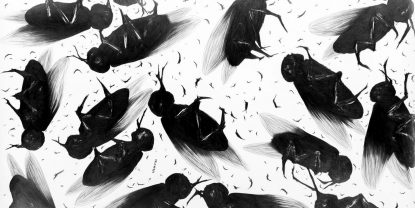Epidemy
Sara Abbasian
November 10 — November 24, 2017
War has always been represented in some artistic fashion, be it in literature, paintings, sculpture or theater. Throughout history, power institutions had the idea of commissioning a set of artists to visit the lines in order to record what they witnessed. Thus, illustration of the glory and suffering of war was a common topic for artistic practices. Today, war is still a critical subject-matter for contemporary artists, as societies ravaged by armed conflicts have paid a massive toll in the loss of human life and economic, political, and social disintegration. More than four million people are estimated to have been killed in violent conflicts since the World War II.
Focusing on conflict, Sara Abbasian creates drawings to address the deepest causes of war: historic antagonism, economic despair, social injustice, and political oppression. She encourages us to consider their immediate and long-term impacts. From her brushes arise grotesque animals and disturbed people who have faced the most traumatic moment that human beings can endure: war, a furnace out of which most of the miseries and virtues of man come.
She expressed her own views of war and the role of the nations and individual in it; in a trilogy. The main idea of these three series is violence, war, carnage, and massacre. The first series, “The Night Blinds Do Not Show Mercy to Each Other,” depicts ghost bats who are cannibals, i.e. they eat their own kind. The second part, “Imperishable Gravity,” represents headless or multi-headed turtles, deformed and transformed by the war or terrorism. “Epidemy” is the third series, portraying not only animals but human beings, multiple drawings, in some of which huge flies are merged with brainsick, insane-looking men. One can imagine that people presented in the artworks are seriously injured, permanently disabled, or psychologically scarred by violence, forced to witness, or even to take part in horrifying acts of aggression.
In “Epidemy,” Abbasian points out that human ingenuity and brutality in using insect-borne diseases in changing the course of major battles, ranging from Napoleon’s military campaigns to the trenches of World War I and the horrific programs of insect warfare during World War II: airplanes dropping plague-infested fleas, facilities rearing tens of millions of hungry beetles to destroy crops, and prison camps staffed by doctors testing disease-carrying lice on inmates.
These are but a few startling examples of weirdly creative, truly frightening, and ultimately powerful ways in which human beings use weapons of war, terror, and torture. Armed conflict have lots of negative effects on cities, infrastructures, public health provision, and social order. There are also cases of deliberate destruction of the environment as a war tactic, such as on the Argentina–Chile border in the 1970s. The environmental impact of biological, chemical, or nuclear weapons is catastrophic. Abbasian impels us to look at these indirect consequences that are often overlooked.
